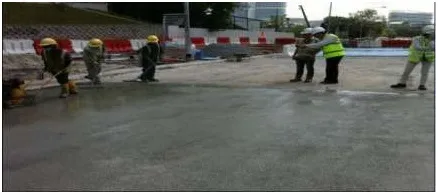A highway pavement consists of layers of processed materials above the natural soil subgrade, whose primary function is to distribute the applied vehicle loads to the sub-grade. The pavement structure should be able to provide a surface of acceptable riding quality, adequate skid resistance, favorable light reflecting characteristics, and low noise pollution. It has to be constructed based on the traffic requirements, climatic conditions of the area, terrain, etc.
Requirements of highway pavement
The primary function of a pavement is to transmit loads to the sub-base and underlying soil. Modern flexible pavements contain sand and gravel or crushed stone compacted with a binder of bituminous material, such as asphalt, tar, or asphaltic oil. Such a pavement has enough plasticity to absorb shock. Rigid pavements are made of concrete, composed of coarse and fine aggregate and portland cement, and usually reinforced with steel rod or mesh. An ideal pavement should meet the following requirements:
- Right thickness to distribute the wheel load stresses to a safe value on the sub-grade soil
- Durable to withstand all types of stresses imposed upon it
- Adequate coefficient of friction to prevent skidding of vehicles,
- Smooth surface to provide comfort to road users
- Impervious surface, so that sub-grade soil is well protected
- Long design life with low maintenance cost
- Thickness should be adequate to transmit the applied loads and distribute them on to a larger area of the soil below
- Hard wearing surface so as to resist the abrasion caused by vehicle tyres.
Structural layers of highway pavement
Base course

It is below the surface course and its function is to distribute the stresses transmitted through the surface course evenly onto the layers below. Invariably, it consists of granular or bituminous material, and acts as a structural part of the pavement. The base course is the most important layer of a road structure which transfers the stresses developed due to traffic impacts through the wearing course. The base course layer provides the required foundation stiffness and structural strength.
Surface Course

It is the topmost layer; its function is to provide a smooth, strong, abrasion-resistant and reasonably impervious course. Since it is directly in contact with the vehicle tyres, it has to resist the imposed wheel loads and transmit them safely to the layer below. The material may be granular, bituminous or cement concrete depending upon the nature of the construction. For flexible pavements, the bituminous surface is the wearing course whereas in rigid pavement the concrete surface act as the base course cum wearing course.
Sub-Base Course

It is just below the base course and provides additional help to the courses above it in distributing the loads. It also helps in preventing soil grains of the subgrade from intruding into the base course above, and counteracts frost action, if any. It may consist of stabilised soil or soil aggregate mixes, which facilitate drainage of free water from the pavement. It comes between the base course and subgrade. The material used for this layer shall satisfy the specifications in terms of gradation, strength, and plastic characteristics. This layer is necessary if the subgrade is of poor quality.
Subgrade

It is the compacted natural soil immediately below the pavement layers; this act as a foundation for the highway. The top surface of the subgrade is called the formation level. Based on the alignment and the nature of the terrain, a roadway may be constructed over an embankment or a cutting, or at or nearly at the natural ground level. The formation of level, therefore, has to be properly decided to suit these conditions. It serves as the foundation and acts as a uniform support to pavements. Subgrades bear the entire load of the payments along with the service load of traffic.
Different types of highway pavements
Flexible pavements

Flexible pavements have base courses of broken stone pieces either compacted into place together with bitumen to form asphalt. These can be either in the form of pavement surface treatments (such as a bituminous surface treatment (BST) generally found on lower volume roads) or, HMA surface courses (generally used on higher volume roads such as the Interstate highway network). These types of pavements are called “flexible” since the total pavement structure “bends” or “deflects” due to traffic loads. A flexible pavement structure is generally composed of several layers of materials which can accommodate this “flexing”. The vertical compressive stress is maximum on the pavement surface directly under the wheel load and is equal to the contact pressure under the wheel. The lower layers of pavement have to take up only lesser magnitudes of stresses and there is no direct wearing action due to traffic loads and weathering action due to environmental factors. Therefore inferior materials with lower cost can be used in the lower layers. The top layer has to be the strongest as the highest compressive stresses are to be sustained by this layer, in addition to the wear and tear due to the moving traffic and varying factors due to weather.
Types of Flexible Pavements
- Conventional layered flexible pavement
- Full – depth asphalt pavement
- Contained rock asphalt mat (CRAM).
Rigid pavements

Rigid pavements are those which possess noteworthy flexural strength of flexural strength or flexural rigidity. The basic design of rigid pavement is very simple. A surface layer, made up of slabs of Portland cement concrete (PCC), sits on top of a handful of sub-layers. The layer directly under the PCC is more flexible than the concrete, but still quite rigid. This layer provides a stable base for the PCC as well as assists in drainage. Some roads have a second sublayer under the first that is even more flexible, while some simply have the existing soil.
Types of Rigid Pavements
- Jointed plain concrete pavement (JPCP)
- Jointed reinforced concrete pavement (JRCP)
- Continuous reinforced concrete pavement (CRCP)
- Prestressed concrete pavement (PCP).
Semi-rigid pavement

A semi-rigid pavement is intermediate between the flexible and the rigid types. The semi-rigid pavement is a composite pavement material consisting a porous asphalt concrete (PAC) with air voids which is filled or flooded by a special formulated high performance polymer modified cement mortar grouting material. It is the combination the characteristics of Porous Asphalt Concrete (PAC) and Portland cement concrete (PCC) pavement. The semi-rigid pavement consists of two main components which are porous asphalt concrete (PAC) and the high performance polymer modified cement mortar grouting material.
Composite pavement

A composite pavement is a type of pavement that utilizes both asphalt and concrete. Typically, a concrete base layer provides structural capacity while an asphalt surface layer provides a wearing surface course. This pavement type can also be used in conjunction with roller-compacted concrete (RCC) pavements, where the RCC pavement provides the structural capacity that the conventional concrete pavement base would.
Conclusion
The performance of the highway pavement depends on the correct usage of structural layer as per fitted with pavement types as discussed above. Pavement performance is an important issue in the operation and planning of highway engineering. There are several factors that affect pavement performance, such as traffic, soil, environmental, economic and stress distribution factors. Go for an experienced pavement engineer to meticulously manage the operation efficiency desired from highway pavement.



